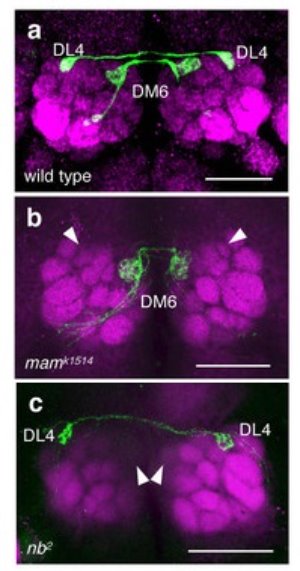Apr. 20, 2007 Research Highlight Biology
Picking up the scent of olfactory neuron differentiation
New findings may explain how the body generates a diverse population of neurons capable of detecting an array of distinct odors
 Figure 1: Two classes of ORNs derived from the same precursor cells normally project to two distinct glomeruli (DM6 and DL4) (a). Mutations in the mam (b) and numb (c) genes cause reciprocal phenotypes. © Nature Neuroscience/ Nature Publishing Group/ 10/ 154 (2007)
Figure 1: Two classes of ORNs derived from the same precursor cells normally project to two distinct glomeruli (DM6 and DL4) (a). Mutations in the mam (b) and numb (c) genes cause reciprocal phenotypes. © Nature Neuroscience/ Nature Publishing Group/ 10/ 154 (2007)
A recent study identifies a signal that ensures that the fruit fly brain can sense a variety of smells. The olfactory sensory system of flies, which closely resembles those of vertebrates, contains many olfactory receptor neurons (ORNs), each of which expresses one of 60 odor receptors. Upon detection of its specific odor, each olfactory receptor fires a signal into the neuron. Each neuron routes this signal through an appendage called the axon, towards a structure called the glomerulus. Each glomerulus gathers and processes signals from neurons expressing a given odorant receptor.
Keita Endo and colleagues in the laboratory led by Chihiro Hama, a scientist at RIKEN’s Center for Developmental Biology in Kobe, set out to determine how precursor cells can give rise to the diverse assortment of ORNs found in the antennae, an external organ of the fly head. Their work is published in Nature Neuroscience 1.
The researchers hypothesized that flies having a flaw in a signaling pathway required for ORN diversification might exhibit altered odorant receptor expression and targeting of ORN axons. They used chemical mutagenesis to create a collection of flies containing genetic defects, and examined ORN axon–glomeruli connections and odorant receptor expression patterns in each mutant fly.
In unmanipulated flies, each ORN within a pair of ORNs projected an axon toward a distinct glomerulus. However, in one mutant fly, both ORNs in a pair sent axons toward a single glomerulus (Fig. 1).
Extensive genome mapping tracked the chemically induced alteration to a gene called mastermind (mam). This gene is required for transmission of signals emanating from the cell surface receptor Notch, a protein previously implicated in the generation of asymmetry among ‘sibling’ precursor cells. ORN–glomeruli connections were altered in a reciprocal fashion in flies expressing a defective version of the numb gene, which encodes a protein needed to shut down Notch signals.
These data indicate that some ORN–glomeruli connections are forged only in the presence of Notch signaling whereas others are made only in the absence of Notch signaling. Similar observations were made with regard to odorant receptor expression patterns.
Thus, variations in Notch signaling bestow upon ORNs distinct axon targeting cues and odorant receptor profiles. However, “Notch signaling is only one of the mechanisms regulating neuronal diversity,” cautions Hama. “More extensive studies are necessary to uncover the whole story. We suspect that Notch-mediated diversification may contribute to the framework of the olfactory circuitry by controlling connectivity between ORNs and second-order neurons.”
References
- 1. Endo, K., Aoki, T., Yoda, Y., Kimura, K. & Hama, C. Notch signal organizes the Drosophila olfactory circuitry by diversifying the sensory neuronal lineages. Nature Neuroscience 10, 153–160 (2007). doi: 10.1038/nn1832

